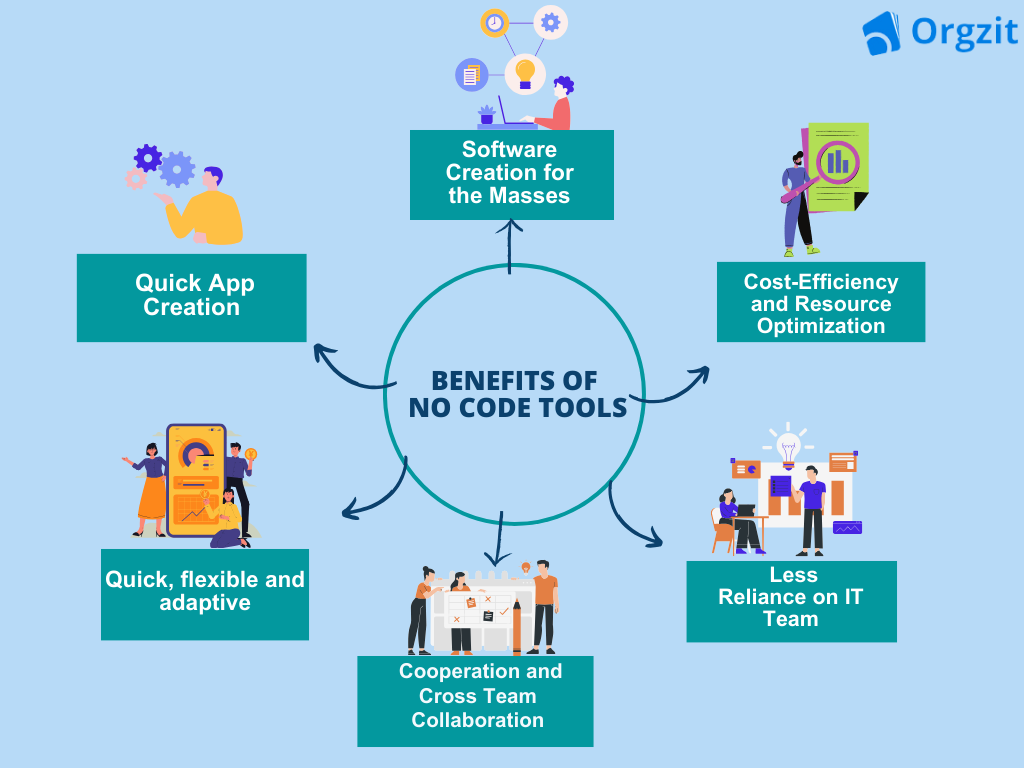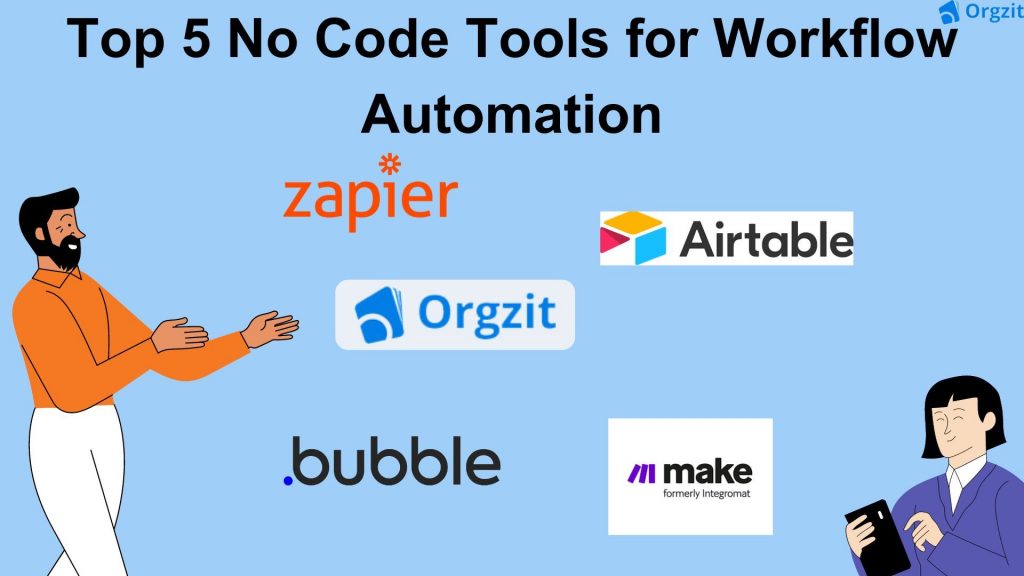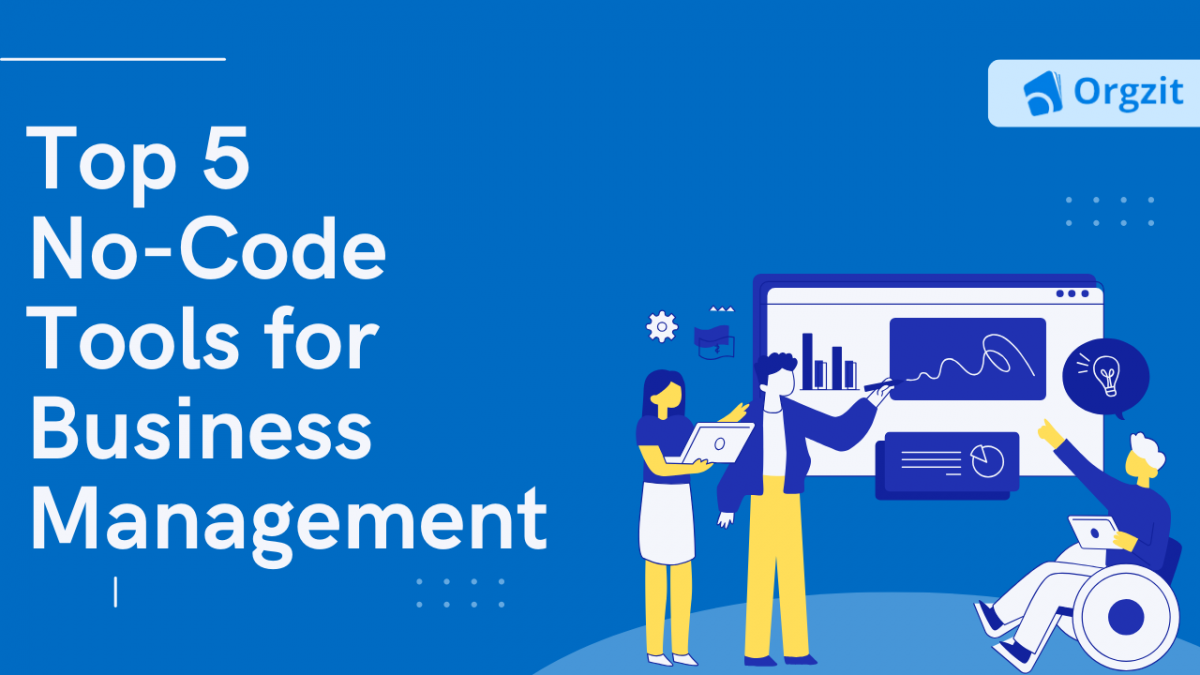Top 5 No-Code Tools for Business Management
No code tools are the future in business management. When it comes to transforming your business with technology, one usually thinks of hiring an IT professional who knows the language of computers. But often, the hired developer may not understand your unique business needs as well as you do.
So you may end up with something that is useless and costs you more money than before. Even today, businesses fret over the idea of digitizing the processes because of the technical difficulty they might face.
People or non-IT businesses see technology as a means to an end. They only want to invest as much time to understand it. Complex code-based IT solutions that need developers may not be their priority in running a business.
But, now things are changing. Technology is adapting itself to the needs of people. An increasingly simplified technology interface that is making mass technology adoption easier. One such technology is NO CODE for business management!
The ease of developing your own applications without using a single line of code is enthralling and exciting. This technology is now available to citizen developers like any of us (non-coders) and is not just limited to being used by developers and IT professionals. Businesses now can develop their own customized apps with little to no knowledge of coding and a lot of creative abilities. And therefore, digital transformation in B2B industry is at the boom.
All businesses, small and big are looking for digital transformation to ease on their work. Not having to repeat the same task manually is very lucrative option for businesses, giving them more time to spend on something more productive.
Business management has never been easy. Managers are literally dousing fires everywhere. From manual errors in pricing, lack of clear data on sales or lack of inventory management on tips costs a missed deal.
But, developing software was a humongous task when you needed an IT professional to digitize your business processes.
However, with the advent of innovative no-code solutions, entrepreneurs and professionals can create tailored applications without the need for intricate coding expertise.
What are No Code Tools in Business Management?
No- Code is a transformative technology that enables a non technical person like you and me to develop applications without the need to know the complex language of computers.
It is particularly remarkable because a business does not need to hire a third party IT team to develop a business management app to simplify their day to day operations.
These user friendly tools provide a simple interface that enables users to design, build, and implement various applications and use cases.
No- Code has many applications, like; website building, mobile apps, workflow automation in business management, CRMs, and chat bots.
No code solution allow users to build applications through drag-and-drop interfaces, pre-built templates, and modular components. Also, it may be done through WYSIWYG (What you see is what you get), integration with API’s, built in debugging and more.
This approach negates the need for manual coding, making software development accessible to more people, including business professionals, entrepreneurs, and subject matter experts who are not from the IT field.
No-Code solutions are rapidly becoming very popular as they are easy to adapt and agile. They can grow with your business and seriously reduce the time of app development compared to complex coding processes.
Moreover, no code’s do-it-yourself technology has made it accessible to every business owner.
Read more on no code applications making digital transformation here.
The Top Benefits of No Code Tools in Business Management
No Code has changed the way applications and software are developed. The inherent agility and fast turn around time in app development have made No-Code solution extremely useful and purposeful.
From optimizing workflows to enabling team collaboration, the advantages of no code solutions are redefining the software development industry. Here are five major benefits of adopting these cutting-edge solutions;


1. Quick App Creation
Traditionally, building an application required intricate coding skills and a considerable time investment. No Code software allows the development of apps on pre built templates, which reduces the time to design and test the application. Automated coding in the background can reduce the labour of developing codes, and it helps in immediate testing.
2. Software Creation for the Masses
Tools that do not require complex coding can be used by both tech and non tech teams together to create apps in collaboration. Individuals with varied experience, from business analysts to marketers, can actively participate in creating software solutions tailored to their needs.
This inclusive nature of no code helps cross-functional teams collaborate on designing and refining applications without the need to depend on a dedicated development team.
3. Cost-Efficiency and Resource Optimization
Traditional software development often demands significant financial resources and specialized developers. No code solutions drastically reduce these costs by minimizing the need for hiring skilled programmers and allocating extensive budgets.
Quick app development means you can improve your business strategies, make users happier, and meet market needs faster. Faster deployment leads to better profits and lower costs.
4. Quick, flexible and adaptive
The no code interface allows the businesses to adapt the application based on changing business demands. As the business grows, the workflow may become complex, and no code application is agile enough to improvise and improve the workflow automations. For instance a no code e commerce platform can evolve its initial basic website to frequently adding updates on new products and services as the business grows.
5. Less Reliance on IT Team
No-code solutions help ease the workload for IT teams because they allow people from the business side, who aren’t tech experts, to create and run apps by themselves. This means they don’t have to ask IT for help and wait for them to do it.
Instead of submitting requests and waiting for developers to address them, non-technical teams can take charge of their digital initiatives.
When there’s less need to rely on IT, it makes things work better and lets IT folks concentrate on important projects that are helping the company change and improve digitally.
A recent study finds out that 82 percent of organizations can’t attract and retain the quality and quantity of software engineers. They are willing to build and maintain their apps using no-code low-code techniques.
6. Cooperation and Cross Team Collaboration
No code software inherently encourages collaboration among different teams and departments. Business units that traditionally operated in silos can now collaboratively design and deploy applications that serve their unique needs.
This promotes a sense of ownership and collaboration across the organization. Different teams can contribute to the application development process, ensuring that the final product aligns closely with business goals.
7. Continuous App Building and Quick Mock Up
No code tools facilitate iterative development and rapid prototyping. Users can create functional mock-ups of applications quickly, allowing stakeholders to visualize the solution before its finalization.
This approach enables users to gather feedback, make improvements, and refine features. As a result, the end product is more closely aligned with user expectations and business requirements.
8. Innovation and Problem Solving
With the technical complexities of coding removed, individuals using no code tools can focus on innovative problem-solving and creative solutions. By channeling their energy into designing user-centric features, exploring novel functionalities, and addressing specific pain points, users can unleash their creative potential and drive innovation within their organizations.
Read more in details on the Benefits of no code tools for building business applications.
The Top 5 No Code Tools for Workflow Automation
As the demand for efficient and agile software development solutions continues to rise, the position of no code solutions has grown exponentially. These platforms enable individuals from non IT backgrounds to create applications, automate processes, and innovate without requiring extensive coding knowledge.
#1 Orgzit
Orgzit is a versatile no code platform that allows users to build custom applications and databases tailored to their business needs. Not only that, you can develop the app in days rather than months. The fast turnaround time of Orgzit app increases the ROI for businesses.
Features:
- Visual interface for creating custom applications and databases.
- Pre-built templates for various use cases.
- Integration with external tools and databases like MailChimp, Slack, Gmail, Zapier, Google Apps, Twillio and many more.
- Workflow automation and task management.
- Collaboration and real-time data sharing.
Usability: Orgzit’s intuitive design makes it accessible for users looking to create customized applications and databases without coding. It can help businesses looking to streamline their complex sales workflow.
Integrations: Orgzit offers integrations with popular tools and services through APIs, enabling seamless data exchange.
Pricing: Orgzit offers flexible pricing plans tailored to various business needs, with a range of features and customization options.
Customization: Orgzit provides extensive customization options, allowing users to design applications as per their requirements.
Pros:
- Orgzit’s visual interface simplifies custom application and database creation, accessible even to non-coders.
- Ready to use templates cater to diverse use cases, expediting project initiation and customization.
- Orgzit’s API-based integrations ensure smooth data exchange with popular tools and databases.
- Automation features of Orgzit optimize processes, automating tasks for enhanced productivity.
- Orgzit promotes team collaboration and informed decision-making through real-time data sharing.


#2 Airtable
Airtable is a versatile no code platform that combines the familiarity of spreadsheets with the power of databases. It helps users to create custom applications, manage workflows, and collaborate in real-time.
Features:
- The drag-and-drop interface for creating databases and applications.
- Rich data types, including text, attachments, checkboxes, and links.
- Customizable views such as grids, forms, and calendars.
- Automation features for task management and collaboration.
- API support for data integration and external applications.
Usability: Airtable’s user-friendly interface makes it suitable for both beginners and experienced users. Its intuitive design allows for quick adoption and customization.
Integrations: Airtable offers integrations with popular tools like Slack, Google Workspace, and more through Zapier and custom API connections.
Pricing: Airtable offers a free plan with limited features. Paid plans start at $12 per user per month, with higher tiers offering advanced features and increased records and attachments.
Customization: Airtable offers customization options, enabling users to tailor databases, views, and workflows to their specific needs.
Pros:
Flexible database and application creation.
Real-time collaboration and communication features.
Automation capabilities for workflow optimization.
Cons:
Limited advanced reporting features.
Pricing can become expensive for larger teams.
#3 Bubble
Bubble is a powerful no code platform that empowers users to create web applications with dynamic functionalities and database integration.
Features:
- Visual drag-and-drop interface for creating web applications.
- Database integration for storing and managing data.
- Workflow automation and logic building.
- Responsive design for mobile compatibility.
- API connectors for external services.
Usability: Bubble offers a robust set of tools that may require some learning for new users. However, its extensive documentation and community support make the learning curve manageable.
Integrations: Bubble supports integrations with popular third-party services through its API connectors.
Pricing: Bubble offers a free plan with limitations and a paid plan starting at $25 per month. Pricing tiers increase based on features and usage.
Customization: Bubble offers high levels of customization, allowing users to build complex web applications with tailored features and functionalities.
Pros:
Advanced web application development capabilities.
Database integration for data management.
Responsive design for mobile-friendly apps.
Cons:
Steeper learning curve for beginners.
Advanced features may require technical knowledge.
#4 Zapier
Zapier is a popular no-code automation platform that allows users to connect and automate workflows between thousands of different web applications and services. It’s designed to simplify the integration of various online tools and automate repetitive tasks, all without the need for coding or extensive technical expertise.
Features:
- Integration with over 3,000 web applications
- Triggers and Actions
- These can be customized to suit your specific needs.
- Pre-built automation templates for common use cases make it easy to start with automation.
- It offers some conditional logic capabilities, allowing you to add decision points in your workflows.
- Transfer data seamlessly between apps
Usability: Zapier’s web-based interface is intuitive and user-friendly, making it accessible to both technical and non-technical users. The visual editor allows you to create Zaps by selecting triggers, configuring actions, and mapping data through a drag-and-drop interface. Zapier offers comprehensive documentation and customer support to assist users in setting up and troubleshooting Zaps.
Integration: Zapier’s app directory is extensive, covering a wide range of categories, including productivity, marketing, CRM, project management, and more.
Custom Integrations: Zapier’s developer platform allows users to create custom integrations with applications that are not available in the app directory.
Pricing: Zapier offers a free plan. Paid plans of Zapier include Zapier for Teams, Business and Enterprise Plans. The pricing depends on the number of users. Zapier also offers custom pricing and enterprise-grade features, including priority support and security controls.
#5 Make
Integromat, now rebranded as Make, is an automation platform enabling users to seamlessly integrate and automate tasks across various online applications. Whether you’re looking to automate data transfers, notifications, or complex business processes, Make simplifies the automation process with its intuitive interface and extensive integration options.
Features:
- Make offers a visual, drag-and-drop editor that makes it easy to design workflows.
- Make supports integration with over 1,500 apps and services, including popular tools like Gmail, Slack, Dropbox, Google Sheets, and more. You can build connections between these apps to automate tasks.
- Make allows you to filter, transform, and enrich data to ensure it’s formatted and utilized effectively.
- The platform offers error handling capabilities.
- You can create multi-step scenarios that include a series of actions and conditions. This flexibility is ideal for automating complex processes.
- Make enables you to schedule workflows to run at specific times or on recurring intervals.
- You can use webhooks to trigger workflows based on external events, making it easy to integrate with custom applications and services.
- Integromat offers filtering and routing options to control the flow of data within your workflows based on specific criteria.
Usability: The visual builder in Make is accessible to users with varying levels of technical expertise. Make provides a library of pre-built templates that you can use as starting points. Users can access comprehensive documentation and support resources to help with setup and troubleshooting.
Integration: Make boasts a diverse app directory, with integrations covering categories such as marketing, CRM, e-commerce, productivity, and more. For applications not available in the directory, Make offers custom integration capabilities through the use of HTTP, JSON, and webhooks.
Pricing: Make offers a free plan with limited operations and automation features. It is suitable for small-scale automation needs. Paid plans are available on a subscription basis, with pricing determined by the number of users and advanced features required. Higher-tier plans offer more automation operations and access to premium support. For larger organizations with extensive automation requirements, Make provides customized enterprise plans with features like custom SLAs, dedicated support, and enhanced security.
Conclusion
Harnessing the power of the best no code tool has become an imperative for businesses that are aiming to succeed.
No code tools have the potential to create solutions without coding. It is evident that choosing the right platform is important for success.
Among the many no code softwares, Orgzit stands out as an affordable solution for various organizational needs. With its intuitive visual interface, pre-built templates, integration capabilities, and workflow automation, Orgzit empowers businesses to design custom applications and databases that streamline processes, improve collaboration, and elevate decision-making.
The ability to create tailored solutions without the complexity of coding aligns perfectly with the contemporary demand for user-friendly and adaptable tools.
Adopting the right no code tool is more than a choice—it’s a strategic investment in future-proofing your organization. By unlocking the potential to innovate and adapt swiftly, businesses can thrive in a rapidly evolving landscape.
Orgzit’s holistic approach bridges the gap between technical and non-technical users. It ensures that organizations can harness the transformative capabilities of no code tools to drive growth and achieve their unique objectives.
As you embark on this journey of digital transformation, selecting a versatile and powerful platform like Orgzit can truly redefine the way your organization operates and paves the way for an era of streamlined operations, enhanced collaboration, and unprecedented efficiency.
FAQ
No Code tools are an easy to use technology that doesn’t require coding knowledge. They simplify the software development with their capabilities to automate coding in the background and visual user interface. They can also help in app building with pre-built templates.
No code platforms are agile and can be adapted to your growing business needs. With a no code platform you can customize your software solution as per your unique needs in days rather than months.
Yes, there are many no code platforms in the market for workflow automations. Of all, the most versatile, affordable option is Orgzit. Other solid no code platforms include Airtable, Bubble, Zapier, and Make.
Orgzit no code platform is a versatile and agile platform available at affordable pricing. With Orgzit’s dedicated customer support, building applications becomes very easy.
No code platforms are popular because it can be easily integrated with popular tools like MailChimp, Google applications, Twillio, Slack, Zapier etc.
No code is an upcoming technology with a lot to offer and develop. No technology is universally fit for all businesses. However, it is versatile and adaptive. It can easily be built upon your requirements as your business grows.









